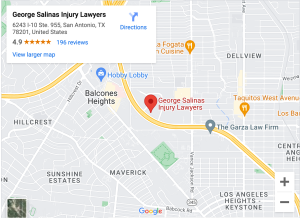
“Pain and suffering” is a term that represents the non-economic damages that an injury victim receives from the responsible party. It compensates the victim for both the physical and emotional distress caused by their injury or illness. It is distinct from economic damages because the harm that ”pain and suffering” damages compensate you for is mostly intangible.
Context: The Full Spectrum of Personal Injury Damages

If you win a personal injury lawsuit in Texas, you might become eligible for economic damages, non-economic damages, and (perhaps) punitive damages.
Economic damages include:
- Medical expenses.
- Anticipated future medical expenses.
- Lost earnings.
- Diminished earning capacity (anticipated future lost earnings).
- Out-of-pocket expenses (child care, etc.).
- Property damage (damage to a vehicle from a car accident, for example).
- Funeral and burial expenses (in a wrongful death case)
Non-economic (“pain and suffering”) damages include:
- Physical pain and suffering.
- Lost quality of life.
- Disfigurement and scarring.
- Mental anguish.
- Loss of consortium (relationship intimacy).
- Physical impairment.
- Loss of companionship and society.
- Inconvenience.
Pain and suffering damages frequently add up to more than half of the total value of a personal injury claim.
There is a third category called punitive damages, but they are rarely awarded even to victorious claimants.
Formulas for Calculating Pain and Suffering
As you might suspect, calculating a dollar value for something as intangible as pain and suffering is not necessarily straightforward. The following two formulas are the most popular.
The Per Diem Method
“Per diem” means “per day.” In this method, you simply calculate a daily value for your pain and suffering and multiply it by the number of days that you suffered.
If your pain and suffering is worth $500/day and you suffered for 100 days, for example, the pain and suffering component of your personal injury claim is worth $50,000. If your pain and suffering is worth $50/day, by contrast, your pain and suffering claim is worth only $5,000.
The Multiplier Method
In the multiplier method, you select a “multiplier,” typically between 1 and 5. You then multiply this figure by the amount by the amount of your total economic damages. If your total economic damages are $50,000 and if your multiplier is 3, for example, your pain and suffering claim will total $150,000.
Practical Limitations on the Value of a Pain and Suffering Claim
The following factors could limit your recovery from a personal injury claim, including the amount you actually receive for pain and suffering.
Your Insurance Coverage
Insurance companies pay most personal injury claims:
- Automobile bodily insurance policies cover car accident injuries;
- Automobile property damage liability insurance policies cover property damage in car accidents;
- Homeowners’ and renters’ insurance typically cover dog bites; and
- Business liability insurance typically covers product liability and premises liability claims.
Auto insurance policies, in particular, leave little room for coverage of pain and suffering claims. Any good lawyer, of course, will follow the “deep pockets” philosophy to locate a potential defendant with the most insurance or business resources to cover your claim. These might include:
- The defendant’s employer, if the employee was on duty at the time;
- The manufacturer of a defective consumer product;
- A commercial truck driver or an Uber/Lyft driver, who are far better insured than ordinary drivers.
- A nightclub or bar if the accident was caused by an intoxicated defendant.
Your lawyer should examine the facts of your case to identify non-obvious third parties.
Comparative Fault
If more than one party is at fault for an accident, Texas will apply its comparative fault rule to distribute compensation. Under Texas law, accident victims can recover (potentially reduced) compensation as long as they are not mostly to blame.
Medical Malpractice Compensation Caps
Texas imposes numerical limitations on how much money you can win in a medical malpractice lawsuit. The purpose is to discourage profiteering or frivolous medical malpractice lawsuits, which ultimately raise the cost of healthcare for everyone. Although the goal is laudable, it could cause you problems if you are the victim of medical malpractice. Texas’s compensation limitations work like this:
- A $250,000 limit on non-economic (pain and suffering) damages for all doctors and individual healthcare providers combined in a single claim;
- A $250,000 limit on any institution, such as a hospital;
- A $500,000 limit on all institutions combined in a single claim.
In wrongful death cases, Texas applies an annual variable limit on the total economic and non-economic damages. This limit goes up every year because it is indexed to inflation. In 2023, it exceeded $2 million. Your lawsuit can be subject to both the wrongful death limitation and the above-listed bulleted limitations at the same time.
Workers’ Compensation Claims
If you were injured at work, you might have to settle for filing a workers’ compensation claim. If this happens, you will not be able to claim any pain and suffering damages at all. Workers’ compensation claims only pay economic damages.
Exiting the workers’ compensation system
Despite this limitation, if you can find a defendant who is not your employer, you might be able to exit the workers’ compensation system and file a personal injury lawsuit against the at-fault defendant. You could then seek pain and suffering damages.
For instance, this might happen if you are a construction worker who suffers an injury due to a dangerous condition on a construction site. If the construction site belongs to a third party (not you or your employer), you might have a valid personal injury claim.
Contact an Experienced San Antonio Personal Injury Lawyer
It’s difficult to place a concrete dollar value on a loss so vague as “pain and suffering.” Yes, courts do it every day, and so do parties negotiating private settlements. The problem is that they reach widely varying estimates of value for very similar injuries.
Nonetheless, that doesn’t have to be a problem if you have hired a San Antonio personal injury lawyer George Salinas Injury Lawyers who will make sure that your compensation award falls on the high end of the possible range of values. Schedule a free initial consultation at (210) 225-0909 to learn more.


